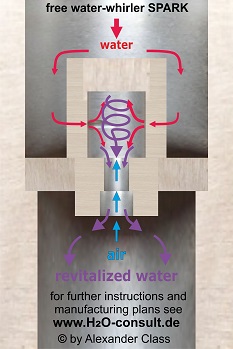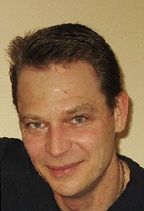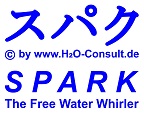SPARK - The Free Water-Whirler www-H2O-Consult.de
![]() englishFree water-whirler SPARK - designed by Alexander Class
englishFree water-whirler SPARK - designed by Alexander Class
 www.H2O-Consult.de - SPARK - the free water whirler - flow diagrampatent-free vortex device for revitalizing and oxygenizing drinking water
www.H2O-Consult.de - SPARK - the free water whirler - flow diagrampatent-free vortex device for revitalizing and oxygenizing drinking water
social project launched by
H2O-Consult
Neustadter Strasse 163
67360 Lingenfeld, Germany
www.h2o-consult.de
The H2O-Consult SPARK is "freeware" - everyone is free to copy it and spread its design around the whole world. But please do respect my immaterial property: Mention my name as inventor plus address and other contact data when copying it. Thank you!
Please note: "FreeWare" is not "OpenSource" - do not change its design or any dimensions if you want to be sure not to imprint any negative information in your drinking water!
Download manufacturing instructions and material recommendations as PDF-file here: Galerie- & Downloadbereich under the title: "SPARK - the free water-whirler by Alexander Class, H2O-Consult, Germany".
Der "FreeWare-Wasserwirbler" SPARK
Der H2O-Consult SPARK ist ein patent- und lizenzfreier Wasserwirbler, den jeder kopieren und selbst herstellen (lassen) kann. Er soll wirklich jedem ermöglichen, in den Genuß wirbelaktivierten Trinkwassers zu gelangen.
Die ausführliche Bauanleitung auf Englisch findet sich im Galerie- und Downloadbereich unter dem Titel: "SPARK - the free water-whirler by Alexander Class, H2O-Consult, Germany".
Natürlich biete ich den Wasserwirbler SPARK auch fertig produziert zum Verkauf an. Privatpersonen oder caritative Organisationen, die ihn an Hilfsprojekte spenden möchten, können entweder eine entsprechende Anzahl SPARK bestellen und dem Projekt ihrer Wahl zukommen lassen oder nur Geld spenden und ich vermittle den Wirbler selbst an eine entsprechende Organisation.
Bitte beachten Sie, daß die Menschen vor Ort über den SPARK und seine Verwendung instruiert sein müssen, damit sie ihn zum Besten aller einsetzen können.
Der SPARK wird in Deutschland gefertigt und von mir zusammengebaut und qualitätskontrolliert. Er kann daher leider nicht zum "Südostasien-Discountpreis" angeboten werden. Dennoch gebe ich ihn zum Selbstkostenpreis ab.
Er ist in CuSn10 gefertigt, einer bleifreien Zinnbronze, die zwar nach einiger Zeit eine braune Patina auf der Oberfläche bekommt und damit nicht mehr so schön wie am ersten Tag aussieht, dank ihrer Zusammensetzung aus Kupfer und Zinn jedoch antibakterielle und insbesondere antilegionelle Wirkung besitzt und darüber hinaus sehr korrosionsbeständig ist.
Eine Auflage in ferritischem Edelstahl ist gaplant und wird demnächst erhältlich sein.
![]() www.H2O-Consult.de - englishH2O-Consult SPARK - the free WaterWhirler (vortex device) for revitalizing water
www.H2O-Consult.de - englishH2O-Consult SPARK - the free WaterWhirler (vortex device) for revitalizing water
designed by Alexander Class, H2O-Consult, Neustadter Strasse 163, 67360 Lingenfeld, Germany, www.h2o-consult.de
Abstract: (theoretical explanation - physics and chemistry of water):
Water cannot only solve thousands of substances but it can just as well store and carry information and energy. The WaterWhirler SPARK erases any harmful information in water and adds energy to it.
Scientists have found out that water is a liquid crystal that does not consist of single H2O-molecules as expected but forms clusters of dozens or even hundreds of H2O-molecules each. These clusters are mostly of irregular structure and are subject to a constant change of shape. Water clusters act as antennas not only for all kinds of electromagnetic radiation but also for the natural resonance of any substance water gets in contact with. That's what scientists call the 'memory of water'. Therefore it is necessary to clean water not only from toxic substances but from harmful frequencies, too. Scientists could prove that symptoms of intoxication can be caused in persons only by drinking water containing the frequency pattern of a toxic substance not really containing any poison. That means: Filtering is not enough. The clusters bearing information have to be dissolved if water is supposed to be healthy.
The mentioned clusters of H2O-molecules are responsible for many of the characteristic features of water. The size of the clusters has remarkable influence on water's ability to flow (rapidly or in small capillaries) and to solve other substances. The smaller its clusters, the more and the easier water can take up other substances, the greater is its solving capacity. That is, for instance, the clue to understanding the special properties that Ferjagins an Fedyakins "polywater" had. The water that had been flowing through extremely small capillaries was necessarily "microclustered" water - showing such a great solving capacity that it managed to dissolve silicium dioxide, which is - for ordinary water - regarded as impossible. That means the traces of quartz (silica) it contained were not just a simple dirt causing false results but indeed a "new form of water" better to be named "Oligowater" instead of "Polywater".
You can imagine a water cluster as a group of persons all holding hands with each other. The more people are free from clusters or engaged in only small clusters the more hands they can reach out to other people = molecules. The 'hands' of the water molecules are called 'hydrogen bonds'. As they are chemical bonds they resemble a certain amount of bonding energy. To release single H2O-molecules from clusters the same amount of energy stored in the hydrogen bonding has to be expended. At the other hand: when single H2O-molecules attach to an existing cluster the bonding energy is released. That's why the size of the water clusters tends to increase permanently unless it is being moved at high speeds under laminar flow conditions. Therefore I designed my vortex chambers: in order to add energy to water by dissolving clusters. That’s why water from the WaterWhirler SPARK is energized water in the true sense of the meaning.
High speed vortex chambers like in the WaterWhirler SPARK driven by water pressure can create the necessary amount of energy to reduce the cluster size remarkably resulting in an increased flowing and solving capacity of the water. This is possible by creating several concentrically flowing vortices spinning in opposite directions thus creating a cascade of smaller vortices ('secondary vortices' also known as 'micro-vortices' or 'nano-vortices') between each other. Another advantage of laminar high speed whirling is the aspiration of air into the water. The spinning vortex creates an amazing amount of suction energy that solves a large quantity of oxygen in the water. That means the WaterWhirler SPARK is true implosion technology as described by Viktor Schauberger, Wilfried Hacheney and others. This results in an accelerated metabolism rate and a reduction of all kinds of diseases in plants, animals and humans. In addition to that, oxygen in water can hold in check pathogenic germs, bacteria etc. for several hours. This has a preserving effect on water and reduces the risk of infectious diseases caused by dirty water.
Practical: (information regarding manufacturing, handling and other things):
To harness all the good effects of vortex water you should keep to the background information given here about manufacturing and use of the Free WaterWhirler SPARK.
Tools required:
The WaterWhirler SPARK can be manufactured with a minimum of tools: any conventional lathe will do. No CNC-device is necessary. The only tools you need are a few simple turning tools, a bunch of drills, a center(ing) or spot(ting) drill (90°), a lever press or a vise to assemble the parts and of course a gauge (gage) to guarantee precise work.
The SPARK does not require thread-cutting. The outer housing of the SPARK is designed in a cylindrical shape and is supposed be fixed to a hose with an ordinary clamp. As threads produce inharmonic distortion of the fine-matter information it is advisable not to cut any threads into the outer rim.
Material needed:
- a round bar with a minimal diameter of 28 mm for the outer housing
- a square bar of 12x12 mm or a hexangular bar of 12 mm for the vortex chamber and its lid
For larger quantities you can save money by using round hollow bars of 32x16 mm for the housing, but then you will need to manufacture an additional part to take up the vortex chamber.
Material recommendations:
- Do not use Aluminum / Do not use any alloy containing Aluminum!!! Traces of aluminum and its harmful information will get into water and make it toxic for plants, animals and human beings!
- Brass, delta metal or silicon tombac are fine if they contain no or little aluminum, arsenic, lead or nickel (1 % maximum). A moderate percentage of iron, manganese, phosphorus, silicon or silver will not disturb.
- Bronze, red brass or gunmetal (copper : tin ratio about 90 : 10 %) with same restrictions regarding toxic elements will perform greatly.
- Pure copper is a bit weak but will do. Tear and wear part number one is the lid of the vortex chamber -> manufacture a second one so that you can change it, when it will be worn.
- Steel: If the WaterWhirler SPARK is removed and dried after every use (blow inside strongly to expel water!) even non-tempered steel can do for a while. But you should better take at least AISI 304, AISI 316 or better ones - then it will last for many years. Optimum results for water quality will bring ferritic steel grades containing no or very little nickel like AISI 430Ti, 434, 436, 439, 441, 442, 444 or 445. For water containing much salt or chlorine the WaterWhirler SPARK should only be made of best steel grades.
Pay attention with plastics! - most of them are too weak and toxic! The only material that works tolerably is POM (Polyoxymethylene). But better look for metal. At least the vortex chamber and its lid should be of metal. If you produce the outer housing of POM, make sure not to screw the clamp of the hose too tightly!
For electrochemical reasons: Do not mix different metals! This may not only cause severe pitting corrosion but also bad water quality!
Accuracy:
All dimensions should be realized as exactly as possible - tolerances not more than ±0,2 mm! For fits not more than ±0,1 mm or ISO-fits p6H7!
Do not change any dimensions! Water not only carries matter and energy but also information. All physical bodies have their typical resonance frequency due to their geometry, material etc. The dimensions shown here harmonize with each other to produce healthy and tasty water. Changing of any dimensions may cause harmful information in water and sickness for plants, animals and humans. This is not only crucial for the vortex chamber but also for outer parts.
The inner surface of the vortex chamber and especially the inlet bores and the outlet bore should be precisely manufactured - if possible ream them. Deburr the edges properly. Otherwise you risk turbulent flow of water resulting in bad quality and cavitation destroying the WaterWhirler SPARK.
Water supply:
Water pressure: A minimum of 1 bar = 14.5 psi is required, best results you will get at >2 bars = 29 psi. (For spraying or other applications up to 20 bars = 290 psi is possible, if the SPARK is produced of stable material. For POM-plastics not more than 3 bars = 43 psi! The result will be an ultra fine nebula of droplets!)
Note that the WaterWhirler SPARK uses the water pressure as a power source for energizing your water. That's why it strongly reduces the flow rate and pressure - typically about 90%. Make sure that your pump, tubes, hoses etc. can stand the emerging counter pressure without taking any harm.
Operation:
Keep in mind that the vortex draws air inside the vortex chamber through the bottom center hole. The more air, the better the water quality will be. Oxygenized water is not only good for health but also holds pathogenic bacteria under control for a certain period of time. Therefore always let the WaterWhirler SPARK spray freely. Do not immerse in water when filling glasses or bottles. Best results you will get when it is mounted vertically.
Of course you can combine your WaterWhirler SPARK with other water treatment systems like e.g. filtering. Note that the SPARK should always be the last one in the row, mounted after all other applications. Make sure that you have enough water pressure for the vortex process after your filter system. This is often a problem - especially with reverse osmosis systems. It may be necessary to install an additional pump to raise the water pressure. It should be more than 2 bars = 29 psi or better 3 bars = 43,5 psi right before the SPARK.
Note what was said before about the reduction of the flow rate and pressure. Make sure that your filter system and pump can stand the emerging counter pressure without taking any harm.
Bottles and canisters:
Try to avoid plastics in contact with vortex water. Plastics have a whole bunch of disadvantages:
- the increased solving capacity of the vortex water will cause even more plasticisers and solvents (like Bisphenol) to diffuse out of the plastic and migrate into your water
- plastic material is so weak that it will damp down the inner movement (on micro-scale) of the water destroying especially the effect of vortex dynamics (micro-vortices spinning in water even hours after energizing it)
- the surface of plastic has tiny pores that offer a perfect substrate for the growth of all kinds of pathogenic bacteria
- transparent or white plastics like PE (polyethylene) or PET (polyethylene terephtalate) will not protect your water from sunlight and worming, resulting in even more growth of algae and bacteria
If you definitely cannot find or handle glass bottles take at least plastic materials that are surely free from hormone-like or other harmful substances. Black PP (polypropylene) of high quality is usually better than all others - even "Tritan" is not recommendable.
Stainless steel of finest quality for bottles is an alternative but keep in mind: Steel - like plastic - usually has a rough surface that is a perfect habitat for all kinds of algae and bacteria. You need to clean the bottles thoroughly before every use.
Best material for vortex water is glass. Dark glass is better - transparent glass bottles have to be protected against direct sunlight. Plastic lids of your bottles should better be replaced by cork. But cork has to be kept clean by always letting it dry completely before using it again. Check daily that the cork does not carry any moist.
Water storage and transport:
Store vortex water in a dark and cool place, not only to prevent bacteria and algae from growing but also to reduce dissipative effects on the water structure. Transport your bottles always in an upright position, fixed properly. Try to avoid long transports. If this is not possible fill the bottles till the upper edge. Do not allow a larger air volume to remain inside the bottle. If a little warming of the vortex water cannot be avoided, allow the pressure to escape from the bottles by lifting the lid, cap or cork for a moment. Do not forget: Water standing a longer time under pressure will tend to form larger clusters of H2O-molecules.
Zur Geschichte des "FreeWare-Wirblers" SPARK
Ein "Anti-Atom"-Wirbler für Fukushima
Als vor einigen Jahren die Fukushima-Katastrophe passierte, erreichten mich mehrere Anrufe von Freunden, Bekannten und Kunden, die mich fragten, ob man nicht vonseiten des Trinkwassers und dessen Informierung respektive Informationslöschung etwas gegen die substanzzerstörenden Auswirkungen der Radioaktivität tun könnte. Ich war begeistert von dieser Idee und mein Kopf begann sofort, die passenden Zahlen dafür auszusuchen und die ersten Pläne zu entwerfen.  www.H2O-Consult.de - Hendrik Hannes - Forscher, Entwickler, Autor, Philanthrop - www.holisticart.euEin Low-Tech-Wirbler für Afrika
www.H2O-Consult.de - Hendrik Hannes - Forscher, Entwickler, Autor, Philanthrop - www.holisticart.euEin Low-Tech-Wirbler für Afrika
Bereits einige Zeit vorher hatte mein Freund Hendrik Hannes angefragt, ob wir nicht gemeinsam ein ganz einfach zu bedienendes und reparierendes mobiles Wasseraufbereitungsgerät für Afrika und andere Länder mit nur rudimentärer Infrastruktur entwickeln könnten, bestehend aus Filtertechnik, Wirbeltechnik und Informationstechnik. Für die Wirbeleinheit des Gerätes hatte ich zum damaligen Zeitpunkt neben einigen CAD-Zeichnungen bereits einen ersten Prototyp gefertigt.
High-Tech oder Low-Tech?
Diese beiden Wirbler unterschieden sich deutlich: ausgehend davon, daß Japan ein hochindustrialisiertes Land mit hervorragenden Produktionsmöglichkeiten wie CNC-Fertigung ist, hatte ich eine komplexe Geometrie für den "Japan-Wirbler" mit aufwendigen Kurven vorgesehen. Im Gegensatz dazu sollte der "Afrika-Wirbler" ein absolutes "Low Tech" Produkt werden mit zylindrischen Formen, die jeder Dreher dieser Welt mit einfachen Werkzeugen auf der primitivsten konventionellen Drehmaschine würde fertigen können.
Alles Geniale ist einfach
Doch dann wurde mir von mehreren Betroffenen berichtet, wie schnell auch bei der Fukushima-Katastrophe zuvor selbstverständliche Dinge zu unüberwindlichen Hindernissen geworden waren. Ich entsann mich der Probleme in der Vergangenheit mit unzureichend genau gefertigten Wirblen und welchen enormen Aufwand an Qualitätsmanagement wir unternehmen müssen, um eine ausreichende Qualität beim Vortexpower SPRING zu gewährleisten. Da wurde mir klar: selbst wenn sich in einem Katastrophengebiet noch Fertigungsmöglichkeiten für einen High-Tech-Wirbler bieten mögen, ist es doch trotzdem besser, die knappen Kapazitäten für andere dringend benötigte Wiederaufbaumaßnahmen frei zu halten.
Weniger ist mehr
Hi www.H2O-Consult.de - SPARK - weniger ist mehrnzu kommt: Je mehr dieser Wirbler eben doch auch auf alten konventionellen Maschinen gefertigt werden können, desto mehr Menschen kann geholfen werden. So landete ich wieder einmal - wie schon so oft in meinem Leben - bei der Erkenntnis: Weniger ist mehr. Außerdem erfuhr ich von Katastrophenhelfern und anderen Augenzeugen in Japan, daß die psychischen Parameter, mit denen man bei einer aktuellen Katastrophe wie Fukushima zu kämpfen hat, gar nicht so verschieden von denen einer dauerhaften Notlage wie in Afrika und anderen Ländern sind.
www.H2O-Consult.de - SPARK - weniger ist mehrnzu kommt: Je mehr dieser Wirbler eben doch auch auf alten konventionellen Maschinen gefertigt werden können, desto mehr Menschen kann geholfen werden. So landete ich wieder einmal - wie schon so oft in meinem Leben - bei der Erkenntnis: Weniger ist mehr. Außerdem erfuhr ich von Katastrophenhelfern und anderen Augenzeugen in Japan, daß die psychischen Parameter, mit denen man bei einer aktuellen Katastrophe wie Fukushima zu kämpfen hat, gar nicht so verschieden von denen einer dauerhaften Notlage wie in Afrika und anderen Ländern sind.
Menschsein
Im Endeffekt ist das Thema in jeder Krise das Gleiche - das Allerweltsthema unseres Planeten: Menschwerdung. Oder vielleicht sollte man sagen: Mensch bleiben (in Anbetracht der Versuchung, sich zum zweibeinigen Raubtier zu entwickeln). Synonyme dafür sind: Gemeinschaftsgeist statt Eigennutz. Etwas philosophischer: Idealismus statt Materialismus. Oder auch: Nachhaltigkeit statt kurzfristigen Vorteilen. Am einfachsten vielleicht: Liebe statt Angst.
Materie und Geist
Daher mußte ein Katastrophen-Wirbler - egal ob für ein modernes Industrieland oder ein "Dritte-Welt"-Land - in jedem Fall ein Low-Tech-Wirbler sein. Leider hatte ich während der Fukushima-Tragödie im März 2011 aus persönlichen und beruflichen Gründen praktisch keine Kapazitäten frei, um wirklich zeitnah Abhilfe zu schaffen, was ich sehr bedaure. So konnte ich damals nicht mehr tun, als einige bestehende Wirbler-Prototypen aus dem Fundus zu kramen, sie in einigen Fällen etwas zu modifizieren und - zusammen mit einigem an Pumpen und Filtermaterial - meinen Freunden zu schicken, damit sie das ärgste Leid vor Ort wenigstens etwas zu lindern vermochten.
A Spark of Hope
 www.H2O-Consult.de - SPARK - The Free Water WhirlerEinige Zeit später ging ich daran, den Low-Tech-Katatstrophen-Wirbler in einigen Details zu modifizieren und nochmals zu vereinfachen - so daß er ohne Gewinde auskommt, aber gleichzeitig zu erweitern, indem ich ihn für wahlweise zwei oder drei Einspritzdüsen auslegte. Und ich machte mir Gedanken darüber, wie man ihn am besten unter's Volk bekommt - über's Internet. Dies war die Geburtsstunde des H2O-Consult "Freeware"-Wirblers. In Erinnerung an die Katatstrophe von Fukushima habe ich ihn SPARK getauft, denn das englische Wort 'Spark' ist als "SuPaKu" auch im Japanischen bekannt. Möge er ein Funke der Hoffnung in allen bestehenden und künftigen Notlagen sein.
www.H2O-Consult.de - SPARK - The Free Water WhirlerEinige Zeit später ging ich daran, den Low-Tech-Katatstrophen-Wirbler in einigen Details zu modifizieren und nochmals zu vereinfachen - so daß er ohne Gewinde auskommt, aber gleichzeitig zu erweitern, indem ich ihn für wahlweise zwei oder drei Einspritzdüsen auslegte. Und ich machte mir Gedanken darüber, wie man ihn am besten unter's Volk bekommt - über's Internet. Dies war die Geburtsstunde des H2O-Consult "Freeware"-Wirblers. In Erinnerung an die Katatstrophe von Fukushima habe ich ihn SPARK getauft, denn das englische Wort 'Spark' ist als "SuPaKu" auch im Japanischen bekannt. Möge er ein Funke der Hoffnung in allen bestehenden und künftigen Notlagen sein.
Hoffung gegen Verzweiflung, Aufbau statt Verfall
Der Freeware-Wirbler SPARK hilft nicht nur, die Qualität des Trinkwassers für Mensch, Tier und Pflanze zu verbessern und einige Zeit stabil zu halten. Dank seiner feinstofflichen Informierung wirkt er auch stark auf der seelischen Ebene. Er nimmt Existenzängste und spendet Hoffnung und Mut. Er unterstützt generell die Durchgeistigung der Materie und hilft somit auch insbesondere bei den substanzzerstörenden Wirkungen der ionisierenden Strahlung aufgrund von Atomzerfall. Aber auch die moralzersetzenden Wirkungen einer massiven Notlage, wo jeder nur noch nach dem Überleben schaut, sind sein Revier.
Freier Fluß für alle!
Der H2O-Consult SPARK ist patentfrei und kann von jedermann nachgebaut werden. Er soll jedoch als "Freeware", aber nicht als "Open-Source" aufgefaßt werden. Damit meine ich, er sollte nicht verändert, sondern so präzise wie möglich kopiert werden. Nur dann entfaltet er die von mir vorgesehenen positiven Wirkungen auf der materiellen und geistigen Ebene. Auch die Materialvorgaben sollten tunlichst eingehalten werden.
Kopieren erlaubt, übersetzen erwünscht.
Ich bitte ich jeden, der das Projekt gut findet, das Wissen zu verbreiten und die Baupläne zu kopieren. Um den Freeware-Wirbler so vielen Menschen wie möglich zugänglich zu machen, wären Übersetzungen der Bauanleitung in andere Sprachen hilfreich. Ich denke hier vor allem an Spanisch, Portugiesisch, Französich, Russisch, Arabisch, Hindi, Chinesisch und afrikanische Sprachen. Auch für eine Verbesserung der englischen Beschreibung wäre ich dankbar. Wer Kenntnisse oder Kontakte in den entsprechenden Bereichen hat und sich eine technische Übersetzung zutraut, soll gerne Kontakt mit mir aufnehmen. Er darf sich der Dankbarkeit vieler gewiß sein.
Eine ausführliche Bauanleitung auf Englisch findet sich im Galerie- Download-Bereich unter dem Titel: "SPARK - the free water-whirler by Alexander Class, H2O-Consult, Germany."